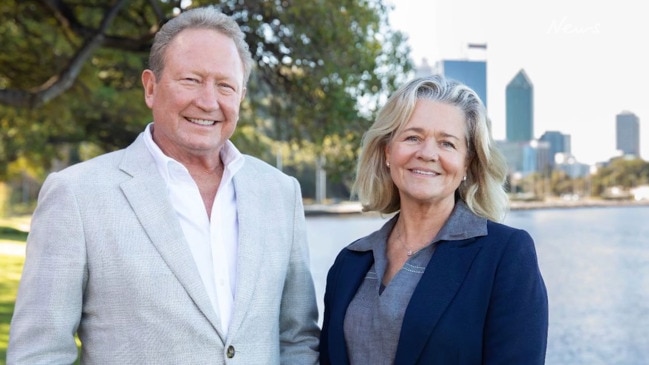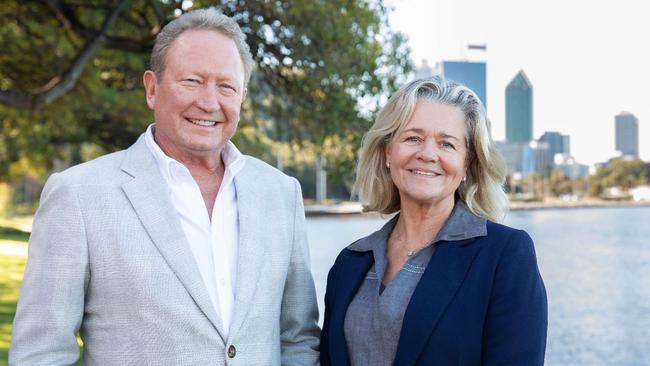Andrew Forrest and wife Nicola marriage breakdown means mining’s succession drama yet to play out


However, such as in the case of the Forrests it can have public implications when there are billions of dollars and the control of a mining empire plus dozens of high-profile private businesses at stake.
So the separation of multibillionaire Andrew and Nicola Forrest, quietly spoken of for more than a year in mining and wider finance circles, was confirmed by the Perth-based family late Wednesday.
The confirmation follows the mammoth $5bn of Fortescue shares being transferred to the pair’s Minderoo charity arm. As part of the same transaction, more than $1bn of Fortescue shares were moved into a new holding company called Coaxial Ventures, controlled by Nicola Forrest.

Despite a tightly-crafted statement pledging alignment of interests between the pair even in separation when it comes to the running of Fortescue, Minderoo and their jointly-owned private vehicle Tattarang (holder of the Fortescue shares), there will be a gnawing doubt in the mind of big market players investing alongside the Forrests about how the stake will be exercised over the longer term.
There will also be questions over whether there is more wealth or assets from RM Williams to property set to change hands inside the $33bn empire, but it all hangs on the complexity of the cross-ownership of the private holdings.
Even with the separation “there is no impact on the operations, control or direction of Fortescue, Minderoo or Tattarang,” the pair said in a joint statement.
Carve-up
Every family situation is different, but markets have to work on what they know.
There is the recent reminder of how the carve-up of Platinum Asset Management between billionaire Kerr Neilson and his former wife Judith played out. On their separation in 2016 the 52 per cent stake in Platinum was split down the middle with the two becoming equal biggest shareholders. There was a commitment under a stability deed to maintain the holding but this was dissolved several years later as Judith sold off her entire stake across several parcels, which had for years remained as an “overhang” that kept a discount on Platinum shares. It also meant that Kerr moved from having a 52 per cent voting block in the company he founded to one that settled at 26 per cent.
Then there is focus on another fund manager Magellan and its high profile co-founder Hamish Douglass following confirmation of a separation from his wife Alexandra late in 2021. The move was part of a series of events that culminated in the exit of Douglass from the day-to-day running of the fund manager as well as a wider collapse of the value in the shares in the business. The two issued a joint statement saying there is no intention to sell shares in Magellan jointly held by a private entity Midas Touch. Filings show Midas Touch continues to remain the largest shareholder in Magellan with the stake unchanged at around 11.4 per cent since then.

For Fortescue there will be no impact on the ground. The iron ore will continue to be trucked and shipped off to willing buyers in China. Indeed one of those carriers is the FMG Nicola, the flagship of Fortescue’s giant shipping fleet.
But recent years have seen a radical shift in the strategy of the miner where executive chairman Andrew Forrest is working towards an all-or-nothing bet on becoming a green hydrogen power. Fortescue is paying for this through the creation of a green energy arm Fortescue Future Industries. The technology is commercially untested and as a hard rock miner Fortescue lacks the institutional expertise on energy. No one in the market doubts Forrest’s ability to deliver on mining promises but there is considerable uncertainty around the likely success of his green ambitions. The question has become whether Forrest can really pull off another Fortescue (building a company from nothing) in such a short timeframe?
There are fears that the massive investment needed will come off the top of Fortescue's healthy dividend stream. If BHP or Rio Tinto made such a pivot they would quickly find themselves punished by their investor base for moving too much out of their lanes.

Meanwhile, does Nicola continue to hold her $1bn in shares over time, or like Judith Neilson of Platinum sell into the market to diversify her holdings. The couple’s three adult children – two daughters and a son – will also be a factor. How will Tattarang, which includes investments in Squadron Energy and nickel be managed? Does Nicola share Andrew’s firm vision on Fortescue Future Industries?
Based on the complexity of the Tattarang structure the status quo should remain for years to come. Another tempering factor is a decade ago both signed the Giving Pledge, committing to give away the majority of their wealth in their lifetimes. The recent $5bn transfer was part of this.
But any nearer term break-up of the Forrests’ jointly held 28 per cent stake could curb Andrew’s overarching influence over every corner of his mining company. A smaller stake would mean he is put into increasingly uncomfortable new territory where outside investors are calling the shots.
CBA takes aim
It was a raspy Commonwealth Bank chief executive Matt Comyn who was keen to press MPs about the free ride global tech players like Google and Apple are getting in the Australian payments market.
Banks are investing heavily to make the payments system safe, secure and reliable, while Comyn points out tech companies are able to use that same infrastructure for no cost under the banner of payments competition.

The comments come as Treasury reviews the payments system around whether the Reserve Bank powers should be updated to include “emerging payments systems” such as digital wallets. The review is also considering whether to add ministerial designation powers to services or platforms that present “risks to national significance”. The Treasury review, which is also examining the role of smaller fintechs in the payments system, closed last week.
“Some of the big tech players – there are no greater examples of gatekeepers. Sort of quasi-monopolistic power has been leveraged and they benefit from it,” Comyn told the House of Representatives standing committee on banks.
While he did not name any companies Comyn says the same players make very little contribution “to the Australian community in the context of the taxes that they pay”.
Meanwhile the CBA boss offered more colour about the health of his lending book, which ranks as the biggest in Australia. Significantly he says it is renters who are feeling the squeeze more than mortgage holders even in the face of surging interest rates.
“On the demographics, we would say that the age band we’re seeing the greatest strain at the moment is between the ages of 30 and 34. The least strain is between 60 and 74. Then there’s obviously dimensions within that and we see renters under more pressure than those who have a mortgage or those who own their own home now.”
In terms of rate hikes there’s “no question that many households are feeling that very directly”, Comyn says. Even those who are comfortably meeting their repayments are starting to pull back spending.
“The quantum of people who are requesting financial assistance that we have offered to extend to and customers who remain behind (in repayments) remains very low,” he added.
He says some 60 per cent of borrowers on ultra-low fixed rate loans have rolled off and this will increase to 85 per cent by the end of the calendar year. This means there will be more
pressure on households over the course of the next six months, even if there are no further increases in the cash rate, simply as more customers come off fixed rates. This too will add to a further slowing of the economy, the bank boss says.
Comyn, who is recovering from Covid-19, dialled in to the hearing from home and managed to keep his voice alive even after three hours of grilling.
johnstone@theaustralian.com.au




For those at the front line, the breakdown of a marriage is a deeply private matter.